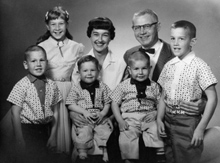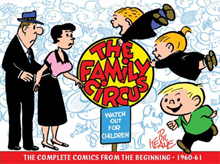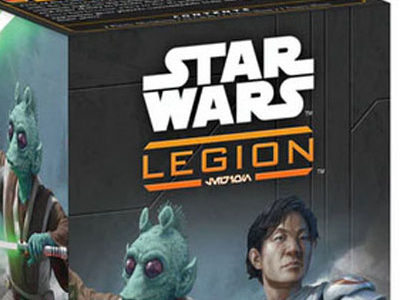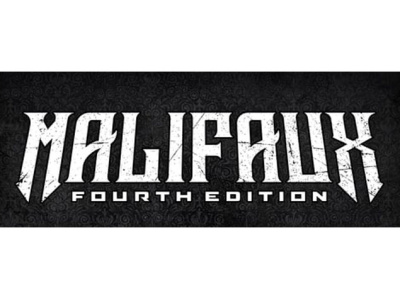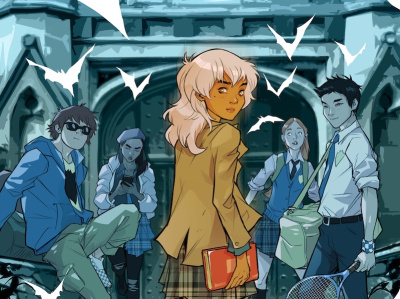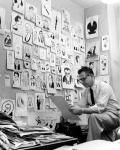
The Family Circus (née The Family Circle and changed when the magazine objected to the name) launched on February 29th 1960 and has run continuously ever since. It was created by Bil Keane, who was eventually joined by his son Jeff who took over inking and colors. Now Jeff Keane does the daily cartoon, which appears in over 1,500 papers. We talked to Jeff about the cartoon, the new IDW collection, and his thoughts on newspaper comics.
We’ve seen the first volume of the new collections and it’s a very beautiful book. How did the deal got done with IDW to do these new packages?
Scott Dunbier called or wrote to my dad a year or so ago and asked if he’d be interested in doing it. And of course my dad said yes. Scott was a Family Circus fan and he knew that the 50th anniversary of the feature was coming up next February so it was a perfect opportunity to finally show all the cartoons that have been done. Recently we’ve had quite a number of books but we would always edit some cartoons or take some out. Some of the early ones, 1960, ’61, have never been in the books at all.
So the unique aspect of this is really starting from the beginning, presented in chronological order, no edits, no cuts, everything as it originally appeared?
Absolutely. And I always find it fascinating because you see a real change in the drawing style, which, of course, is much more simple back then when my dad was inking all the stuff himself. Just seeing the characters the way they’re drawn and how it progressed over time is sort of a marvel.
What was the source material? Do you still own all the originals?
We don’t have all the originals because we’ve given a lot of originals to
So the proofs are what the syndicate would send back?
That’s right. You draw the original and then you’d send it and then of course the syndicate would copy them or however it was that they did them then, make proofs, and then they would distribute it to the newspapers also by mail. We always had copies of those that we would get from them showing what they had sent to the newspapers.
You mentioned how the strip has evolved. It seems like the dad’s appearance changed more than any of the other characters. Why do you think that is?
I agree with you. The dad has changed the most. He used to look like a big fat clumsy guy.
When you look at the photos in the introduction, it’s a less flattering caricature in these initial strips than it is now.
(Laughter) When my dad started it, I’m not sure he wanted to identify himself necessarily with the cartoon or necessarily have it be identifiable as our family. In fact, in a couple of those, Dad is actually referred to as “Steve.” He had sort of the generic businessman look in those days: wearing a hat, a little bit heavy, drinking and smoking. Sort of Mad Men-like.
It’s the same era, 1960s, right?
When he started cartooning he would go to the Philadelphia Bulletin and work there. He would be commuting in every day to the newspaper and back because he was the editor of the Fun Book there, which was about an eighteen page section. The center of it was eight pages of Will Eisner’s The Spirit. He would do cartoons and it would be games and puzzles. It was a great newspaper section. He would go into work each day and come home. It wasn’t until we moved to
So the evolution of the dad character was kind of related to that move and the change in his life?
It was always our family but I don’t know when he started that he wanted it necessarily to be our family, to make it that specific. I think the evolution was just a natural progression. It was so associated with our family that after, I don’t know, maybe three years it was clear that Daddy was our dad and Mommy was my mom and my brothers and sisters. Of course there was no PJ because I was the youngest.
Tell us a little bit about what’s happening with the strip now. Your dad must be in his eighties maybe?
Dad’s eighty-seven.
Is he cartooning any more? Is it a family operation?
He helps me; he’ll send me some roughs and some ideas and things. He’s not as involved as he used to be. My mom passed away on Memorial Day weekend of last year. Since then he’s been less hands-on then he used to. But he’s still there, he still reads, he still tells me if I do anything wrong.
Are you the primary cartoonist now?
I’m the only cartoonist.
Are you planning to do the same thing your dad did and pass this on to a third generation of Keanes?
I have no idea. Who knows where newspapers will be or however it’s being done.
How many papers is this in now?
It’s in over 1,500.
Is that domestic or world wide?
It’s world wide but there’s not as many in other countries as some cartoons. I know it’s in
Is that the peak it’s been at or has it ever been in more?
It’s kind of maintained its level for ten, fifteen years or so. Papers will drop it and then other papers will pick it up. We’ve been pretty lucky as far as losing or gaining papers. A lot of times there’s a big paper that might drop it but then there’s other papers around that area that might pick it up.
What do you think the future of comics in the newspapers is?
If I knew that I’d be the smartest guy in the world, and I probably wouldn’t be a cartoonist. There’s no way of knowing. I think that newspapers have to figure out what their appeal is exactly to people. I always find it very disappointing that they continue to reduce the comics as opposed to using the comics as a selling tool as they used to. The Sunday paper used to be wrapped in the comics. Now you can barely find them, and everything’s so small. I appreciate the fact that they continue to run the stuff but I don’t think it does them a lot of service by making it so small that it becomes harder to read. People might just want to go on the Internet and see it in a larger size. I know that you can’t really give away things for free. There’s got to be some sort of model for how the comics can be used from the Internet and still bring newspapers the profits that they want. I know the one section of the newspaper that I think people always read or buy newspapers for is the comics.
I get the L.A. Times and I get the Orange County Register. The L.A. Times does a pretty good job with the comics at a readable size. The Register does all right on the daily; Sunday gets pretty small. It’s hard. I’ve actually changed drawings because I know it’s reduced down so small that you have to really simplify stuff. In some ways you’re killing yourself because then they go ‘Look. I can reduce it. I can still read it!’ But it would be nice to be able to have a consistent size.
If we figured this out right there’s something like 18,000 strips out there from the time it was created until now. That’s obviously a lot of gags. Do you feel like you’re familiar with all of them? How do you keep it fresh and how do you avoid repeating?
We don’t necessarily avoid repeating. You change the situations. You change the TV to a flat screen TV or you make it where it’s coming off the computer or they’re talking about Facebook. I think a good thing with our cartoon is, families don’t change much as far as their feelings for each other and the love and all of that stuff. The environment certainly changes around them. I will redo cartoons that have been done before but have them seem more current, or change the dialogue
There are always new things. My dad has a whole file of gags and things that he had saved from when we were growing up. I’ve got a whole file that I was doing when my kids were growing up. So I use those and you play off them, see how you can, maybe this character can be saying this or that. The main thing is to maintain the family feel. It’s not necessarily a ‘ha ha,’ joke. My dad always said it’s a tug at the heart or a lump in the throat. Sometimes that’s a more effective cartoon and that I think is the unique quality of The Family Circus.
With this book you can see in those early years it was much more of a gag a day type of cartoon. As the years go through all of a sudden you’ll see where there’s sort of a sentimentality that’s there and a true love for each other that starts to get expressed. I think that really came through from my mom. He realized that sort of the unique quality of this particular cartoon was his ability not to be afraid to make something emotional as opposed to just a joke.
Who do you think influenced him in that development in the creation of The Family Circus? What cartoonists did he admire?
He idolized George Lichty and George Price when he started cartooning. He says his favorite cartoonist working today is me.
He was really looking at the other single panel type cartoonists?
Yes. He tended to always be doing a single panel. When he was in the Army in WW II, there would be single panel gags. I guess the only strip he did in some ways was Silly Philly which was on the opening page of the Fun Book that he did for
When he was selling his magazine cartoons was when he realized he could move out of
How about you? What comics in the newspapers today do you enjoy?
I like Pearls Before Swine, I’ve certainly enjoyed Zits. New things come out. Now what I find is sometimes I go back to cartoons that I dropped reading for awhile. I know I kind of stopped reading Peanuts for awhile and then all of a sudden sometimes a newspaper will move cartoons around and then you’ll find ‘oh this is right by something else I’m reading’ so I’ll start reading that again. I enjoy reading Luann, or all of a sudden I’ll start reading Hagar which I might not have been reading much before. As you get older or your life changes all of a sudden…like Dilbert. I didn’t really read Dilbert much back in the nineties when I had little kids running around and stuff. But now I really enjoy reading Dilbert in the business section because I just find it so funny. He just writes so beautifully. All of a sudden, phases in your life change and you start reading different comics. I think I might find that newspaper page to be pretty boring if it didn’t have the eclectic mix of types of cartoons and gags or stories or ones that are more of a story, whatever it is.
This has been great. It’s a really beautiful book.
I think they did a great job of putting it together. It really makes me happy to see all the old cartoons. I find myself just looking back and laughing at them, and going ‘what a great gag that was.’ It’s such an honor for us. We’re going to have all those cartoons that are out there so finally people will be able to read from the beginning and hopefully not get too sick of it.
We really love that introduction too because it placed it in the context of your lives. We always knew there was a family there but never knew how close the family in the strip, especially after those first couple of years, reflected your real family.
I think that Chris’ introduction is perfect for the book. It sets it in the right context. And you can see certain things in the cartoon that start to be clearly, here’s where we’re doing this, here’s where we’re doing that. That’s the way it always was for us. I could always follow the events in our lives by reading the cartoon. You would see where we’re on vacation. We went to the beach. And then sure enough the Family Circus would be going to the beach. We’d go to



